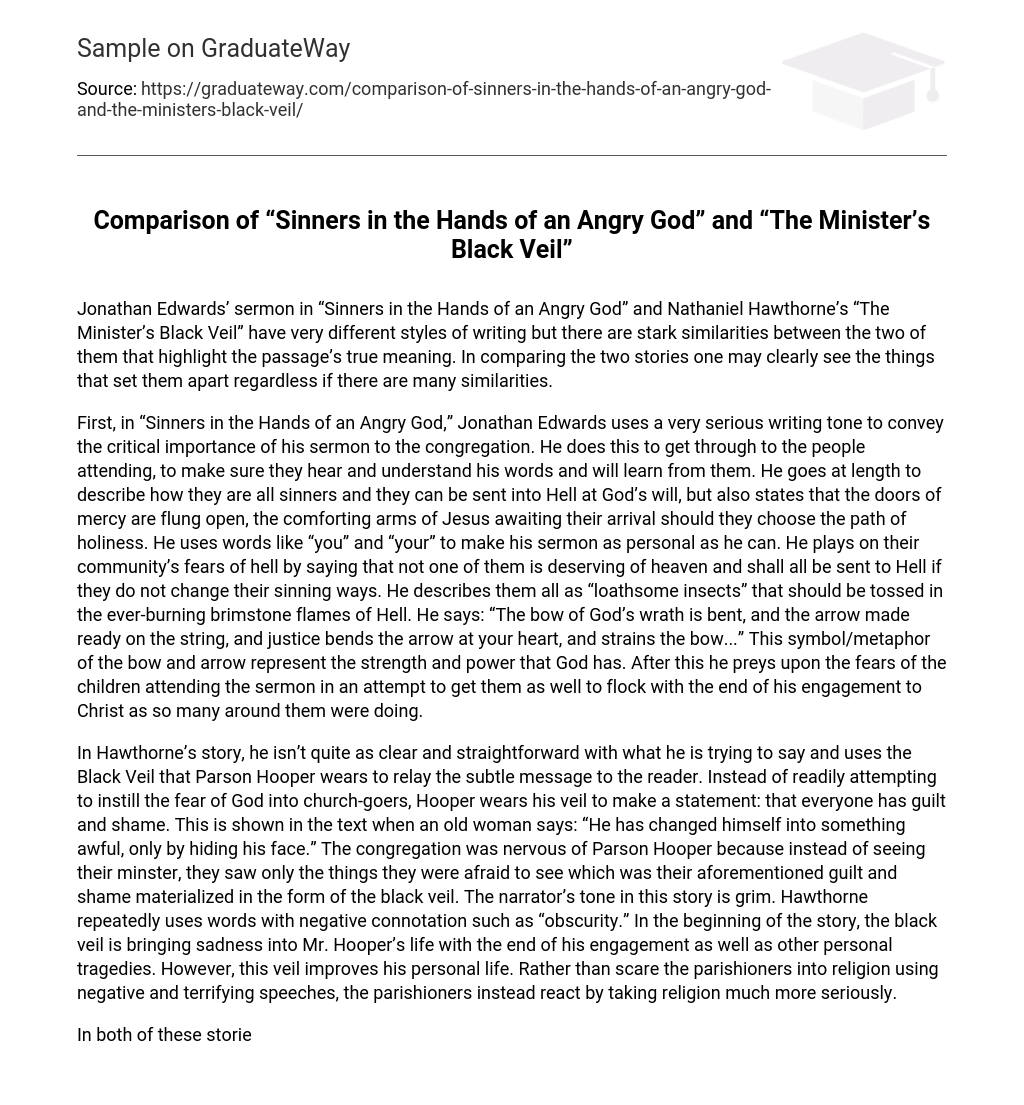Jonathan Edwards’ sermon in “Sinners in the Hands of an Angry God” and Nathaniel Hawthorne’s “The Minister’s Black Veil” have very different styles of writing but there are stark similarities between the two of them that highlight the passage’s true meaning. In comparing the two stories one may clearly see the things that set them apart regardless if there are many similarities.
First, in “Sinners in the Hands of an Angry God,” Jonathan Edwards uses a very serious writing tone to convey the critical importance of his sermon to the congregation. He does this to get through to the people attending, to make sure they hear and understand his words and will learn from them. He goes at length to describe how they are all sinners and they can be sent into Hell at God’s will, but also states that the doors of mercy are flung open, the comforting arms of Jesus awaiting their arrival should they choose the path of holiness. He uses words like “you” and “your” to make his sermon as personal as he can. He plays on their community’s fears of hell by saying that not one of them is deserving of heaven and shall all be sent to Hell if they do not change their sinning ways. He describes them all as “loathsome insects” that should be tossed in the ever-burning brimstone flames of Hell. He says: “The bow of God’s wrath is bent, and the arrow made ready on the string, and justice bends the arrow at your heart, and strains the bow…” This symbol/metaphor of the bow and arrow represent the strength and power that God has. After this he preys upon the fears of the children attending the sermon in an attempt to get them as well to flock with the end of his engagement to Christ as so many around them were doing.
In Hawthorne’s story, he isn’t quite as clear and straightforward with what he is trying to say and uses the Black Veil that Parson Hooper wears to relay the subtle message to the reader. Instead of readily attempting to instill the fear of God into church-goers, Hooper wears his veil to make a statement: that everyone has guilt and shame. This is shown in the text when an old woman says: “He has changed himself into something awful, only by hiding his face.” The congregation was nervous of Parson Hooper because instead of seeing their minster, they saw only the things they were afraid to see which was their aforementioned guilt and shame materialized in the form of the black veil. The narrator’s tone in this story is grim. Hawthorne repeatedly uses words with negative connotation such as “obscurity.” In the beginning of the story, the black veil is bringing sadness into Mr. Hooper’s life with the end of his engagement as well as other personal tragedies. However, this veil improves his personal life. Rather than scare the parishioners into religion using negative and terrifying speeches, the parishioners instead react by taking religion much more seriously.
In both of these stories, the presence of secrets and dark areas are very evident both literally and metaphorically. In “The Minister’s Black Veil,” the mystery does not surround Parson Hooper along but involves all of the people in his quiet town. This is proven by their by their reaction to his sermons about secret sin and while it could be argued that the discomfort the parishioners feel is the result of the unsettling presence of the black veil it is heavily hinted that they are guilty of said secret sin. In “Sinners in the Hands of an Angry God,” the dark areas lie in Jonathan Edwards’ sermon. Edwards pulls no punches when it comes to putting the sinfulness of human beings on blast. He states that those who belong in the category of the unrepentant may be those who are verbally and physically wicked and reject God, or they might be people who are fine with how things are. They should belong to a group of people who believe and they think they can ride that community’s back to avoid judgement. But Edwards views sin as an active force in the world that is controlled solely by the Devil himself. He states that anyone who hasn’t experienced some form of ‘awakening,’ as had those who had been converted to Puritan beliefs during this time period, are considered a servant of the devil and will be sent to hell.





